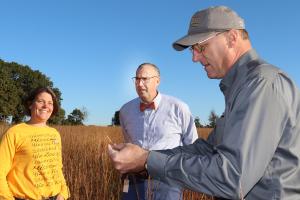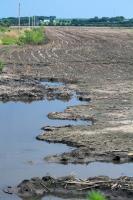Dr. Bug is on call when kids ‘bug’ you about bugs
KANSAS CITY, Mo. – Snow days and winter holidays give parents and child care workers openings to teach kids about the wonders of nature. “Winter break is a great time to teach children about insects and gardening,” says University of Missouri Extension horticulture specialist Tamra Reall. “Books they received as holiday gifts, TV shows or movies may spark their interest and prompt questions.”
Poinsettias, not toxic, not too tasty
COLUMBIA, Mo.– Scientific studies have declared the poinsettia harmless, but the plant is still dogged by its reputation as a grave menace to children and pets.“It’s a myth that poinsettias are toxic,” said University of Missouri Extension horticulturist David Trinklein.
Positive approaches to negativity on social media
SPRINGFIELD, Mo. – Putting your community in the social media limelight brings the risk of receiving occasional negative comments. You might be thinking, “Won’t negative comments turn other potential customers away?” Not necessarily, says David Burton, county engagement specialist with University of Missouri Extension.
Warm-season grasses provide forage, wildlife habitat
CASSVILLE, Mo. – Richard Asbill wants cattle and wildlife to benefit from warm-season grasses on his southwestern Missouri farm.Asbill, the superintendent of the Cassville R-IV School District and a former agriculture teacher, is one of the first participants in the NRCS + MU Grasslands Project. The project is a collaboration between the University of Missouri and the USDA’s Natural Resources Conservation Service.
Put your best fork forward: National Nutrition Month
National Nutrition Month is a nutrition education campaign launched each March by the Academy of Nutrition and Dietetics. The campaign expanded from National Nutrition Week to National Nutrition Month in 1980 to reflect growing professional support and increased public interest in nutrition. The goal of the campaign is to reiterate the basics of healthy eating and to celebrate the expertise of registered dietitian nutritionists.
Be prepared for the next big storm
BETHANY, Mo. – Be prepared for the next big storm BEFORE it happens in your area.“That means having a safe place, with a supply of food, water and other items ready to use when and where you may need them,” says University of Missouri Extension nutrition and health education specialist Janet Hackert.“If an underground shelter is not available, move to an interior room or hallway on the lowest floor,” she says. “Stay away from windows.”
Missouri agricultural weather wind information and resources
A wind rose is a graphical presentation of the average hourly speed and direction of wind at a particular location. The wind rose consists of 16 petals that indicate the percent of time that a wind is blowing from that direction. By looking at the wind rose, one can quickly see the prevailing wind direction. The petals of the wind rose also are composed of different colors that represent the percent of time that a wind from that…
Nitrogen: Flex and go fast
It's April 4 and raining again in central Missouri. A lot of work planned for fall did not get done. Opportunities to catch up in late winter or early spring have been nil. I expect a spring where the value of good decisions will be magnified.
Strategies for nitrogen on wheat this spring
It was a difficult fall in Missouri and much of the Midwest. Crops came out late, crops came out wet, fields were rutted, wheat got planted late or not at all, and once the wheat was up it found itself in a hostile (cold & wet) environment.
Off-target movement of dicamba in Missouri: Where do we go from here?
The situation. In 2017, there have been numerous instances of off-target movement of dicamba throughout the state of Missouri and beyond. While the majority of the injury on a per land unit area has definitely occurred in the boot heel of Missouri, there are many problems with off-target movement of dicamba in the rest of the state.
Survey of Missouri Pesticide Applicator Practices, Knowledge, and Perceptions
The introduction of soybean and cotton traits with resistance to synthetic auxin herbicides has led to an increase in concern over the off-target movement of dicamba and 2,4-D. A direct-mail survey was sent to Missouri pesticide applicators in January of 2016 to understand current herbicide application practices and applicator knowledge and awareness of the new synthetic auxin technologies.
Funding available through the MFA Volunteer Fire Grant
MFA Incorporated representatives Craig Childs and Pam Hiller present che
Weed management issues related to the flooding and wet conditions in Missouri
Obviously, our season so far has been one for the books. Our state climatologist Pat Guinan tells us that last month was the wettest May on record ever! We’ve been fielding a number of questions over the past several weeks related to the wet weather and how this affects our herbicides and weed management practices. In this article, we present a few brief thoughts that provide some answers to the most common questions we’ve been getting.
New tests by MU scientists will kill weed seeds before they become weeds
COLUMBIA, Mo. - Kill seeds before they become hard-to-kill weeds. That plan will be studied by Kevin Bradley with help from Missouri farmers.The University of Missouri Extension weed specialist plans research on crushing seeds before they hit the ground. That stops weeds competing with crops next season. Over time, that depletes soil seed banks.
New Region C training coordinator appointed at MU FRTI
Region C Training Coordinator: Aaron Bockhorst of Union, Missouri.
University of Missouri leads call for broadband
Editorial by Marshall Stewart, vice chancellor for extension and engagement and chief engagement officer for UM System.
Christine Tew: 4-H helped plant the seed for ‘growing my network’
Christine Tew"Home team" typically refers to a favorite sports team. But Christine Tew’s home team is made up of the people who root hardest for her.
Beth Snyder: A childhood passion to a successful business
Beth SynderAs kids we often respond to the question, "What do you want to be when you grow up?" with answers like a princess, an astronaut, or superhero. The reality 20 years later is almost never the same. However, for Beth Snyder, that is not the case.
Dicamba labels and regulations
Following EPA and state pesticide labels and regulations is important for liability concerns. Most business general liability insurance coverages do not cover illegal activities. If the label is not followed, it may impact the coverage a business has for causing damage to another person’s property. To aid farmers and businesses in complying with pesticide regulations, educational information on EPA and state regulations are summarized…
Dicamba injury and insurance
Dicamba can cause injury to off-target plants, leading to third-party injury claims that involve business liability insurance plans. Third-party injury is when the actions of one person affect another person.
Third-party injury and federal crop insurance
Multi-peril crop insurance is overseen by the U.S. Department of Agriculture Risk Management Agencies. For row crop producers, the most common multi-peril crop policies purchased are revenue protection and yield protection. Both of these insurance products use the insured farmer’s actual yields in determining the level of indemnity, if any, to be paid.
Professional liability insurance
Perhaps the best-known type of professional liability insurance is malpractice insurance carried by medical professionals. Professional liability insurance carried by other professionals, such as accountants and architects, is frequently called errors and omissions insurance. Professional liability insurance is intended to covers lawsuits arising from professional services.
Wantland tops 2019 state 4-H dairy judging contest
Lila Wantland judged herself to the top of the senior division of the Missouri State 4-H Dairy Judging Contest. The contest was held Aug. 17 at the Missouri State Fair in Sedalia. Wantland was the high individual in the intermediate division of the state contest in 2018.
Extension specialist offers tips to repair flood-damaged fields
COLUMBIA, Mo. – Lessons from past floods tell how to bring flooded fields back into production, says Kent Shannon, University of Missouri agricultural engineering specialist. Shannon says there are three stages to repairing flood-damaged fields. 1. Remove debris and sediment Burn plant material such as cornstalks and trees on the land where they were found. Bury ashes there also.





